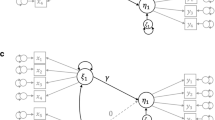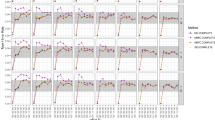Abstract
It is common to encounter latent variables with ordinal data in social or behavioral research. Although a mediated effect of latent variables (latent mediated effect, or LME) with ordinal data may appear to be a straightforward combination of LME with continuous data and latent variables with ordinal data, the methodological challenges to combine the two are not trivial. This research covers model structures as complex as LME and formulates both point and interval estimates of LME for ordinal data using the Bayesian full-information approach. We also combine weighted least squares (WLS) estimation with the bias-corrected bootstrapping (BCB; Efron Journal of the American Statistical Association, 82, 171–185, 1987) method or the traditional delta method as the limited-information approach. We evaluated the viability of these different approaches across various conditions through simulation studies, and provide an empirical example to illustrate the approaches. We found that the Bayesian approach with reasonably informative priors is preferred when both point and interval estimates are of interest and the sample size is 200 or above.


Similar content being viewed by others
Notes
The BCB method cannot be implemented in Mplus up to now.
The MCMC engine in Mplus was not well understood and studied, as compared with that in the more-accessible BUGS program, when we conducted the simulation study.
References
Arbuckle, J. L. (2006). Amos 7.0 users’ guide. Chicago, IL: SPSS.
Arnold-Berkovits, I. (2002). Structural modeling with ordered polytomous and continuous variables: A simulation study comparing full-information Bayesian estimation to correlation/covariance methods (Unpublished dissertation), University of Maryland, College Park, MD.
Baron, R. M., & Kenny, D. A. (1986). The moderator–mediator variable distinction in social psychological research: Conceptual, strategic, and statistical considerations. Journal of Personality and Social Psychology, 51, 1173–1182. doi:10.1037/0022-3514.51.6.1173
Bernardo, J. M., & Smith, A. F. M. (1994). Bayesian theory. New York, NY: Wiley.
Bollen, K. A. (1989). Structural equations with latent variables. New York, NY: Wiley.
Bradley, J. V. (1978). Robustness? British Journal of Mathematical and Statistical Psychology, 31, 144–152.
Casella, G., & George, E. I. (1992). Explaining the Gibbs sampler. American Statistician, 46, 167–174.
Chen, J., & Choi, J. (2009). A comparison of maximum likelihood and expected a posteriori estimation for polychoric correlation using Monte Carlo simulation. Journal of Modern Applied Statistical Methods, 8, 337–354.
Chen, J., Choi, J., Weiss, B. A., & Stapleton, L. (2014). An empirical evaluation of mediation effect analysis using the Morkov chain Monte Carlo and alternative estimation methods. Structural Equation Modeling, 21, 253–262. doi:10.1080/10705511.2014.882688
Cheung, G. W., & Lau, R. S. (2008). Testing mediation and suppression effects of latent variables: Bootstrapping with structural equation models. Organizational Research Methods, 11, 296–325.
Chib, S., & Greenberg, E. (1995). Understanding the Metropolis–Hastings algorithm. American Statistician, 49, 327–335.
Efron, B. (1987). Better bootstrap confidence intervals. Journal of the American Statistical Association, 82, 171–185.
Flora, D. B., & Curran, P. J. (2004). An empirical evaluation of alternative methods of estimation for confirmatory factor analysis with ordinal data. Psychological Methods, 9, 466–491. doi:10.1037/1082-989X.9.4.466
Forero, C. G., & Maydeu-Olivares, A. (2009). Estimation of IRT graded response models: Limited versus full information methods. Psychological Methods, 14, 275–299.
Fritz, M. S., Taylor, A. B., & MacKinnon, D. P. (2012). Explanation of two anomalous results in statistical mediation analysis. Multivariate Behavioral Research, 47, 61–87. doi:10.1080/00273171.2012.640596
Gelman, A., Carlin, J. B., & Stern, H. S. (1995). Bayesian data analysis. London, UK: Chapman & Hall.
Gilks, W. R., Richardson, S., & Spiegelhalter, D. J. (Eds.). (1996). Markov chain Monte Carlo in practice. London, UK: Chapman & Hall.
Hallquist, M. (2010). MplusAutomation package (Version 0.3-2). Retrieved from http://cran.opensourceresources.org/
James, L. R., & Brett, J. M. (1984). Mediators, moderators and tests for mediation. Journal of Applied Psychology, 69, 307–321.
Jöreskog, K. G. (2002–2005). Structural equation modeling with ordinal variables using LISREL. Retrieved from www.ssicentral.com/lisrel/techdocs/ordinal.pdf
Jöreskog, K. G., & Sörbom, D. (1996). LISREL 8: User’s reference guide. Chicago, IL: SSI.
Judd, C. M., & Kenny, D. A. (1981). Process analysis: Estimating mediation in treatment evaluations. Evaluation Review, 5, 602–619.
Lee, S.-Y. (2007). Structural equation modeling: A Bayesian approach. Chichester, UK: Wiley.
Lunn, D., Spiegelhalter, D., Thomas, A., & Best, N. (2009). The BUGS project: Evolution, critique, and future directions. Statistics in Medicine, 28, 3049–3067.
Lynch, S. M. (2007). Introduction to applied Bayesian statistics and estimation for social scientists. New York, NY: Springer.
MacKinnon, D. P., Lockwood, C. M., Hoffman, J. M., West, S. G., & Sheets, V. (2002). A comparison of methods to test mediation and other intervening variable effects. Psychological Methods, 7, 83–104. doi:10.1037/1082-989X.7.1.83
MacKinnon, D. P., Lockwood, C. M., & Williams, J. (2004). Confidence limits for the indirect effect: Distribution of the product and resampling methods. Multivariate Behavioral Research, 39, 99–128. doi:10.1207/s15327906mbr3901_4
MacKinnon, D. P., Warsi, G., & Dwyer, J. H. (1995). A simulation study of mediated effect measures. Multivariate Behavioral Research, 30, 41–62.
Muthén, B. (1983). Latent variable structural equation modeling with categorical data. Journal of Econometrics, 22, 43–65.
Muthén, B. (1984). A general structural equation model with dichotomous, ordered categorical, and continuous latent variable indicators. Psychometrika, 49, 115–132. doi:10.1007/BF02294210
Muthén, B., & Asparouhov, T. (2002). Latent variable analysis with categorical outcomes: Multiple-group and growth modeling in Mplus (Mplus Web notes No. 4). Retrieved from www.statmodel.com/download/webnotes/CatMGLong.pdf
Muthén, B., du Toit, S. H. C., & Spisic, D. (1997). Robust inference using weighted least squares and quadratic estimating equations in latent variable modeling with categorical and continuous outcomes. Retrieved from www.statmodel.com/bmuthen/articles/Article_075.pdf
Muthén, L. K., & Muthén, B. (2010). Mplus user’s guide (6th ed.). Los Angeles, CA: Muthén & Muthén.
Olsson, U. (1979). Maximum likelihood estimation of the polychoric correlation coefficient. Psychometrika, 44, 443–460.
R Development Core Team. (2010). R: A language and environment for statistical computing. Vienna, Austria: R Foundation for Statistical Computing. Retrieved from www.R-project.org
Samejima, F. (1969). Estimation of latent ability using a response pattern of graded scores. New York, NY: Psychometric Society.
Sobel, M. E. (1982). Asymptotic confidence intervals for indirect effects in structural equation models. Sociological Methodology, 12, 290–312.
Sobel, M. E. (1987). Some new results on indirect effects and their standard errors in covariance structure models. Sociological Methodology, 16, 155–176.
Song, X.-Y., & Lee, S.-Y. (2001). Bayesian estimation and test for factor analysis model with continuous and polytomous data in several populations. British Journal of Mathematical and Statistical Psychology, 54, 237–263.
Takane, Y., & de Leeuw, J. (1987). On the relationship between item response theory and factor analysis of discretized variables. Psychometrika, 52, 393–408.
Thomas, A., O’Hara, B., Ligges, U., & Sturtz, S. (2007). Making BUGS open. R News, 6, 12–17.
Wirth, R. J., & Edwards, M. C. (2007). Item factor analysis: Current approaches and future directions. Psychological Methods, 12, 58–79. doi:10.1037/1082-989X.12.1.58
Yuan, Y., & MacKinnon, D. P. (2009). Bayesian mediation analysis. Psychological Methods, 14, 301–322. doi:10.1037/a0016972
Acknowledgments
This research was supported by the Humanities and Social Sciences Research Grant from the Ministry of Education in China. Grant No.: 14YJA880005.
Author information
Authors and Affiliations
Corresponding author
Appendix A: BUGS code of the Bayesian approach for LME with ordinal data
Appendix A: BUGS code of the Bayesian approach for LME with ordinal data

Rights and permissions
About this article
Cite this article
Chen, J., Zhang, D. & Choi, J. Estimation of the latent mediated effect with ordinal data using the limited-information and Bayesian full-information approaches. Behav Res 47, 1260–1273 (2015). https://doi.org/10.3758/s13428-014-0526-3
Published:
Issue Date:
DOI: https://doi.org/10.3758/s13428-014-0526-3




